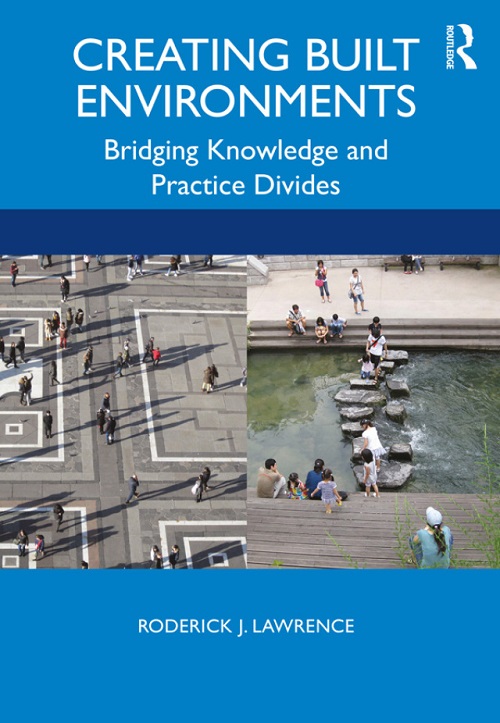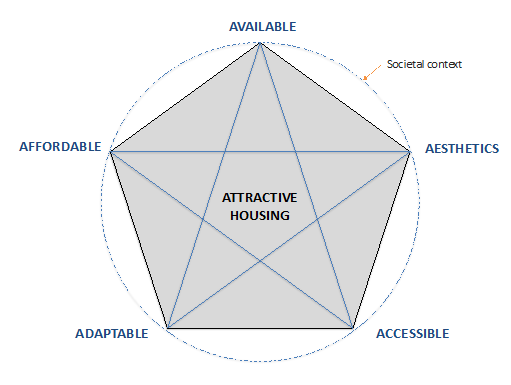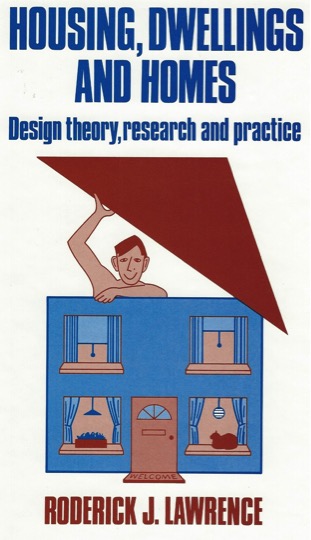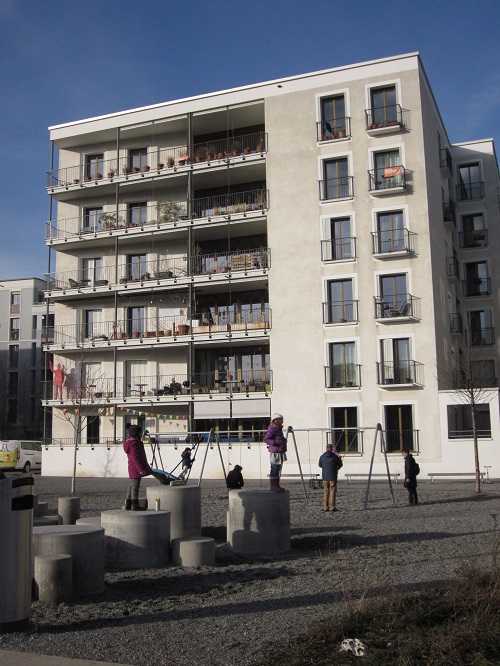Housing Matters for All
Housing is a complex challenge that has become a persistent problem in many cities around the world. We maintain that we do not need more data or research; we need more effective action founded on political commitment, innovative policies and creative professional practice including the active contribution of residents. Innovative projects confirm that this is achievable in cities north and south of the Equator.
Martin Heidegger, a German philosopher, explained that dwelling is a fundamental human condition which has become disconnected from housing and building.[1] Housing surveys in many countries since the 1960s confirm that housing conditions inhibit dwelling inside and around residential buildings whether these are villas, row houses, or flats. This mismatch between what providers think about housing and the residential needs and preferences of residents underlines important differences between the core values that each group attributes to housing. Despite over 50 years of housing research these differences remain.[2] This applicability gap between what we know about housing and what we build confirms that empirical knowledge does not always influence the supply of housing in the public and private sectors.

Figure 1: The cover of our book ‘Creating Built Environments: Bridging Knowledge and Practice Divides’ which includes a chapter ‘Housing Matters for All’ (Routledge: London & New York).
In my new book ‘Creating Built Environments: Bridging Knowledge and Practice Divides’ [3] I presented and illustrated the advantages and challenges of implementing transdisciplinary contributions that have been used in innovative projects for food, health, housing, mobility and transport. I proposed and illustrated how housing design and construction should shift from generalized norms about ‘user requirements’ of stereotypical households for rationalized housing to a more plural approach that accommodates the growing diversity of activities, lifestyles and needs that are expressed in the changing residential activities of inhabitants across their lifespan. I think that this shift acknowledges the importance of housing choices by reconnecting dwelling to housing and building. In addition, it endorses the United Nations Habitat Agenda which states that housing is a fundamental human right.
We know that there are many ways that diverse housing requirements can be translated into the design, layout and construction of residential environments, and we explain there are collateral benefits in implementing them both in new housing construction and the renovation of existing residential buildings. We also know that our health and well-being begin at home. There is an urgent need for more effective action that provides housing conditions for all types of households that nurtures and support health. I think it is not too late to overcome the mismatch between what we know and what we build to accommodate people with different domestic cultures, needs and preferences.
Our international review analysed encouraging and important contributions of a third non-profit sector for new housing construction and renovation. This third sector, commonly known as cooperative and collective housing in many cities north and south of the Equator, has achieved results not reached by either the public or private sector in cities.[4] For example, in Zurich, which has a high cost housing market dominated by the private rental sector, local residents are included as active contributors in the definition of housing options for diverse households including single persons, one-parent families, and elderly citizens.[5] One example is Mehr als Wohnen. a large cooperative housing and mixed-use development constructed in the Hunziker Areal from 2008 to 2015. This exemplary project was constructed on a large industrial redevelopment site of 4 hectares. The project, shown in Figure 2, includes 13 large buildings up to 7 floor levels having 370 apartments that can accommodate up to 1300 residents in units of different layout and size, some with communal spaces, services and facilities. It shows how knowledge and information about housing and domestic culture are generated by explicitly involving residents in co-design processes and the co-benefits this creates. This mixed-use development confirms that a more balanced approach between environmental, economic and social criteria is feasible and achievable in a highly regulated housing market dominated by private sector contributions.
Figure 2: View of Mehr als Wohnen showing one cooperative residential building constructed in Zurich. Source: R. Lawrence.
Innovative projects presented in my book raise fundamental questions about the responsibility of all those professionals in the provision of housing that should be attractive, accessible, affordable and adaptable for a wide range of households. The ultimate goal of designing housing should be to creatively combine different experiences and needs of residents with the professional knowledge and know-how of practitioners in the housing sector. Overcoming the current applicability gap between research and practice, knowledge and action, is an important challenge for all those who wish to improve housing for current and future generations.
30 September Update
This blog was started last month to explain that housing matters for all households even though it has not received the priority or commitment it deserves from recent governments and public authorities at national and local levels in some countries.
We began by describing and illustrating alternative to housing provision by the private and public sectors. Notably a third sector called cooperative and collective housing has been a regular provider of housing in several European countries and large cities, including Copenhagen, Stockholm, Vienna, and Zurich for more than a century. Notably, in the context of cuts in public spending for the housing sector in some countries since the 1990s, this third housing sector has established innovative benchmarks for the construction of new housing applying ecological, economic, ethical, and social principles of urban sustainable development. The case of Zurich we presented is but one example, whereas public and private housing has rarely achieved the same for a needs of increasingly diverse households.
A key question that warrants more consideration is “What constitutes the attractiveness of housing for current and future generations?”
I have answered this question in my recent book by considering Attractiveness with respect to five A variables shown in Figure 1: Aesthetics, Availability, Affordability, Accessibility and Adaptability. These key variables are influenced by internal variables in housing markets (e.g. housing costs, vacancy rate), and external variables at national regional and global levels (e.g. employment, migration). Given their dynamic and unpredictable properties monitoring is necessary at national and local levels.

Figure 1: Our research indicates that the attractiveness of housing units is influenced by combinations of variables that can be considered in terms of the availability of housing units in property markets, the aesthetics of housing units and residential buildings, the affordability of housing for households, the accessibility of housing in terms of site location, and the adaptability of housing units to accommodate changing lifestyles and needs. These variables are dependent on the societal context in which housing occurs, and they are influenced by both internal and external factors that change.
Is it not too late for housing to become the foundation of just and fair public policies and a new social contract? A shared commitment is needed that supports investments in the renovation of inefficient housing stocks and the construction of new housing units that nurture and sustain healthy living conditions for all households, especially the elderly, migrants, unemployed persons, and single parent households? We recall that, a century ago, housing policies were prioritized in Britain, and other countries, in the aftermath of the First World War, and municipal housing developments became benchmarks for private housing construction. We need to look back at these achievements for the future. When will politicians, civil servants and private investors learn important lessons from the past for the betterment of current and future generations?
ACCOMMODATING CHANGE
This commentary extends the last one on 30.09.2020 about the attractiveness of housing. It discusses how and why housing should accommodate demographic change and changing lifestyles. We argue that housing should be concerned by our world of changing household size and composition, and evolving lifestyles and technologies at home and beyond the front door. Will the housing sector respond effectively to these challenges?
There have been various propositions about how housing can accommodate societal changes. The most common is providing a diversified housing stock that responds to the needs and preferences of increasingly different kinds of households. This proposition follows an objective of housing providers to match various household needs with diverse housing units. Given that housing requirements of specific households change across the life-course, this proposition assumes that residents move if and when housing markets provide choices. However, this approach devalues the meaning of home acquired during residence, especially the personal values and psychological attachment to housing, and the interpersonal bonds created with neighbours.
An alternative architectural and technical proposition is that housing should be physically adaptable, perhaps extendable too. Adaptable housing could be achieved by constructing residential buildings with moveable partition walls that enable change by residents if and when required. A well-known example is ‘Supports’ proposed by John Habraken. He distinguished between the communal components (‘the support’) and the private components (‘the infill’) of residential buildings for multiple households. Habraken (1972, p.79) wrote: “A support structure is a construction which allows the provision of dwellings which can be built, altered and taken down, independently of others”.
One example of this kind of adaptable housing has been constructed by the Danish firm Henning Larsen Architects. It is part of an experimental housing project, called MiniCO2 Houses, erected in 2013, in the coastal town of Nyborg, Denmark.[6] Each of the six model houses show that the carbon footprint and CO2 emissions can be reduced during the design, construction, occupation and maintenance of housing. The external walls of these adaptable housing units are load bearing, whereas the internal walls are moveable partitions. The potential capacity to change internal walls can be applied during the life course of households (e.g. after the birth of a child, or the departure of an adolescent), and following changes in lifestyle (e.g. home-based work, or new domestic technologies).
A third proposition derived from housing history concerns the inherent adaptability of housing units defined by their internal spatial design (e.g. the size and shape of rooms), and the organization of internal spaces (e.g. rooms with independent access rather than sequencing). Consider the changeable purposes of rooms that are designed as neutral spaces (e.g. a room that can become a bedroom, a dining room, or an office for home-based work). This quality is the antithesis of ‘form follows function’, which led some architects and interior designers to consider rooms only for a specific function (e.g. the ‘laboratory kitchen). The main advantage of inherent adaptability is that change does not involve any modifications to the physical structure of housing.

Each of these options has its merits and shortcomings. What is important is that they interpret the potential for residents to make fundamental choices about their housing conditions and become active agents of household and societal change. The providers of housing should be concerned about the appropriateness of new and renovated housing to accommodate household and societal change, especially the constantly evolving needs of current and future generations.
If you found this of interest, Roderick has suggested the following publications for further reading:
- Roderick Lawrence (2011). Housing for health promotion (opens new window). International Journal of Public Health, 56 (6): pp. 577-578.
- Roderick Lawrence (2011). Looking back for the future (opens new window). International Journal of Public Health, 56 (6): pp. 581-582.
- Roderick Lawrence (2004). Housing and health: from interdisciplinary principles to transdisciplinary research and practice (opens new window). Futures, 36 (4): pp.487-502.
- Bridget Franklin, Housing Transformations: Shaping the Space of Twenty-First Century Living. London: Routledge, 2006.
- Margrit Hugentobler, Anreas Hofer, Pia Simmendinger (eds.) More than Housing: Cooperative Planning- A Case Study in Zurich. Basel: Birkhauser, 2016.
- Julia Robinson, Complex Housing: Designing for Density. New York & London: Routledge, 2018.
- John Habraken (1972). Supports: An alternative to mass housing. London UK: Architectural Press. (Original Dutch edition, 1961. New edition by The Urban International Press, 1999).
- Roderick Lawrence (1987). Housing, dwellings and homes: Design theory, research and practice. Chichester UK: John Wiley.
- Roderick Lawrence (2021). Creating Built Environments: Bridging knowledge and practice divides. London & New York: Routledge.
And for more on designing inclusive communities and age-friendly housing, visit the Housing LIN online design hub to view a range of other useful resources. https://www.housinglin.org.uk/Topics/browse/Design-building/
Lastly, if you would like to talk through any of the issues raised in this guest blog and/or find out how the Housing LIN can assist your organisation, email us at: info@housinglin.org.uk
[1] Martin Heidegger, Building Dwelling Thinking. Lecture ‘BauenWohnen Denken’ presented to the Darmsdat symposium on 5th August 1951. Published in M. Heiddeger, Poetry, Language, Thought. Translated by A. Hofstadter. New York: Harper & Row, 1971.
[2] Roderick Lawrence, ‘Mind the Gap: Bridging the divide between knowledge, policy and practice’. In H. Barton, S. Thompson, S. Burgess & M. Grant (eds.) The Routledge Handbook of Planning for Health and Well-Being, pp. 74-84, New York & London: Routledge, 2015.
[3] https://www.routledge.com/Creating-Built-Environments-Bridging-Knowledge-and-Practice-Divides/Lawrence/p/book/9780815385394 (opens new window)
[4] Housing Cooperatives Worldwide: http://www.housinginternational.coop/ (opens new window)
[5] Mehr als Wohnen Housing Cooperative in Zurich: https://www.mehralswohnen.ch/ (opens new window)
[6] https://www.archdaily.com/546890/adaptable-house-henning-larsen-architects-gxn (opens new window)


Comments
Add your comment